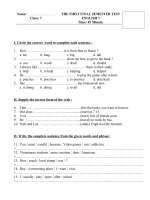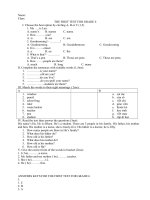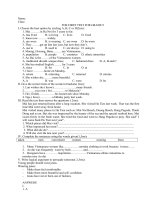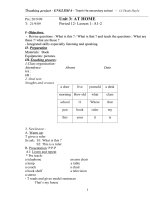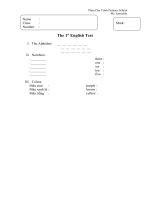The first 100 chinese characters
Bạn đang xem bản rút gọn của tài liệu. Xem và tải ngay bản đầy đủ của tài liệu tại đây (3.22 MB, 197 trang )
Tai Lieu Chat Luong
Dear Reader: In order to view all colored text and non-English text
accurately,pleaseensurethatthePUBLISHERDEFAULTSSETTINGon
yourreadingdeviceisswitchedtoON.ThiswillallowyoutoviewallnonEnglishcharactersandcoloredtextinthisbook.—TuttlePublishing
PublishedbyTuttlePublishing,animprintofPeriplusEditions(HK)Ltd.
www.tuttlepublishing.com
Copyright©2006byPeriplusEditions(HK)Ltd.
Allrightsreserved.
LCCCardNo.2009387018
ISBN:978-1-4629-0171-5(ebook)
Distributedby:
NorthAmerica,LatinAmerica&Europe
TuttlePublishing
364InnovationDrive
NorthClarendon,VT05759-9436
Tel:1(802)7738930
Fax:1(802)7736993
www.tuttlepublishing.com
Japan
TuttlePublishing
YaekariBuilding3F
5-4-12Osaki,Shinagawa-ku
Tokyo141-0032,Japan
Tel:(81)354370171
Fax:(81)354370755
www.tuttle.co.jp
Asia-Pacific
BerkeleyBooksPteLtd
61TaiSengAvenue#02-12
Singapore534167
Tel:(65)6280-1330
Fax:(65)6280-6290
www.periplus.com
131211101098765
PrintedinSingapore
TUTTLE PUBLISHING® is a registered trademark of Tuttle Publishing, a division of Periplus Editions
(HK)Ltd.
Contents
Introduction
一yī
二èr
三sān
四sì
五wǔ
六liù
七qī
八bā
九jiǔ
十shí
你nǐ
您nín
好hǎo/hào
请qǐng
问wèn
贵g
姓xìng
他tā
她tā
叫jiào
什shén/shí
么me
名míng
字zì
我wǒ
是shì
大dà
学x
生shēng
中zhōng/zhịng
英yīng
文wén
课kè
老lǎo
师shī
同tóng
校xiào
小xiǎo
朋péng
友yǒu
们men
呢ne
谢xiè
再zài
见jiàn
美měi
国g
人rén
吗ma
也yě
不bù
谁shéi/sh
的de
家jiā
爸bà
和hé
妈mā
哥gē
姐jiě
弟dì
妹mèi
住zhù
在zài
这zhè
女nǚ
儿ér/r
那nà/nèi
男nán
孩hái
子zi/zǐ
都dōu/dū
没méi
有yǒu
做z
事shì
两liǎng
个gè
多duō
少shǎo/shào
时shí
间jiān
今jīn
天tiān
几jǐ/jī
号hào
明míng
年nián
月y
日rì
星xīng
期qī
早zǎo
上shàng
下xià
午wǔ
吃chī
晚wǎn
饭fàn
了le/liǎo
哪nǎ/něi
HanyuPinyinIndex
RadicalIndex
English–ChineseIndex
ListofRadicals
Introduction
Learningthecharactersisoneofthemostfascinatingandfunpartsoflearning
Chinese,andpeopleareoftensurprisedbyhowmuchtheyenjoybeingableto
recognizethemandtowritethem.Addedtothat,writingthecharactersisalso
thebestwayoflearningthem.Thisbookshowsyouhowtowritethesecond100
mostcommoncharactersandgivesyouplentyofspacetopracticewritingthem.
Whenyoudothis,you’llbelearningawritingsystemwhichisoneoftheoldest
in the world and is now used by more than a billion people around the globe
everyday.
Inthisintroductionwe’lltalkabout:
howthecharactersdeveloped;
thedifferencebetweentraditionalandsimplifiedformsofthecharacters;
whatthe“radicals”areandwhythey’reuseful;
howtocountthewritingstrokesusedtoformeachcharacter;
howtolookupthecharactersinadictionary;
how words are created by joining two characters together; and, most
importantly;
howtowritethecharacters!
Also,incaseyou’reusingthisbookonyourownwithoutateacher,we’lltell
youhowtogetthemostoutofusingit.
Chinesecharactersarenotnearlyasstrangeandcomplicatedaspeopleseem
tothink.They’reactuallynomoremysteriousthanmusicalnotation,whichmost
peoplecanmasterinonlyafewmonths.Sothere’sreallynothingtobescaredof
orworriedabout:everyonecanlearnthem—itjustrequiresabitofpatienceand
perseverance. There are also some things which you may have heard about
writingChinesecharactersthataren’ttrue.Inparticular,youdon’tneedtousea
specialbrushtowritethem(aball-pointpenisfine),andyoudon’tneedtobe
goodatdrawing(infactyoudon’tevenneedtohaveneathandwriting,although
ithelps!).
Howmanycharactersarethere?
Thousands!Youwouldprobablyneedtoknowsomethingliketwothousandto
beabletoreadChinesenewspapersandbooks,butyoudon’tneedanythinglike
that number to read a menu, go shopping or read simple street signs and
instructions.Justasyoucangetbyinmostcountriesknowingaboutahundred
wordsofthelocallanguage,sotooyoucangetbyinChinaquitewellknowinga
hundredcommonChinesecharacters.Andthiswouldalsobeanexcellentbasis
forlearningtoreadandwriteChinese.
Howdidthecharactersoriginallydevelop?
Chinese characters started out as pictures representing simple objects, and the
firstcharactersoriginallyresembledthethingstheyrepresented.Forexample:
Someothersimplecharacterswerepicturesof“ideas”:
Some of these characters kept this “pictographic” or “ideographic” quality
about them, but others were gradually modified or abbreviated until many of
themnowlooknothingliketheoriginalobjectsorideas.
Then,aswordswereneededforthingswhichweren’teasytodraw,existing
characterswere“combined”tocreatenewcharacters.Forexample,女(meaning
“woman”)combinedwith子(meaning“child”)givesanewcharacter好(which
means“good”or“tobefondof”).
Noticethatwhentwocharactersarejoinedtogetherlikethistoformanew
character,theygetsquashedtogetheranddeformedslightly.Thisissothatthe
new,combinedcharacterwillfitintothesamesizesquareor“box”aseachofthe
original two characters. For example the character 日 “sun” becomes thinner
whenitistheleft-handpartofthecharacter时“time”;anditbecomesshorter
when it is the upper part of the character 星 “star”. Some components got
distorted and deformed even more than this in the combining process: for
examplewhenthecharacter人“man”appearsontheleft-handsideofacomplex
characteritgetscompressedinto亻,likeinthecharacter他“he”.
Soyoucanseethatsomeofthesimplercharactersoftenactasbasic“building
blocks”fromwhichmorecomplexcharactersareformed.Thismeansthatifyou
learn how to write these simple characters you’ll also be learning how to write
somecomplexonestoo.
Howarecharactersreadandpronounced?
ThepronunciationsinthisworkbookrefertomodernstandardChinese.Thisis
theofficiallanguageofChinaandisalsoknownas“Mandarin”or“putonghua”.
The pronunciation of Chinese characters is written out with letters of the
alphabet using a romanization system called “Hanyu Pinyin”—or “pinyin” for
short. This is the modern system used in China. In pinyin some of the letters
have a different sound than in English—but if you are learning Chinese you’ll
alreadyknowthis.Wecouldgiveadescriptionhereofhowtopronounceeach
sound,butitwouldtakeupalotofspace—andthisworkbookisaboutwriting
the characters, not pronouncing them! In any case, you really need to hear a
teacher(orrecording)pronouncethesoundsoutloudtogetanaccurateideaof
whattheysoundlike.
EachChinesecharacterispronouncedusingonlyonesyllable.However,in
additiontothesyllable,eachcharacteralsohasaparticulartone,whichrefersto
howthepitchofthevoiceisused.InstandardChinesetherearefourdifferent
tones,andinpinyinthetoneismarkedbyplacinganaccentmarkoverthevowel
asfollows:
Thepronunciationofeachcharacteristhereforeacombinationofasyllable
andatone.ThereareonlyasmallnumberofavailablesyllablesinChinese,and
manycharactersthereforesharethesamesyllable—infactmanycharactersshare
thesamesoundplustonecombination.TheyareliketheEnglishwords“here”
and “hear”—when they are spoken, you can only tell which is which from the
contextorbyseeingthewordinwrittenform.
Apart from putonghua (modern standard Chinese), another well-known
typeofChineseisCantonese,whichisspokeninsouthernChinaandinmany
Chinesecommunitiesaroundtheworld.Infactthereareseveraldozendifferent
Chinese languages, and the pronunciations of Chinese characters in these
languages are all very different from each other. But the important thing to
realize is that the characters themselves donotchange. So two Chinese people
whocan’tunderstandeachotherwhenthey’retalkingtogether,canwritetoone
anotherwithoutanyproblematall!
Simplifiedandtraditionalcharacters
As more and more characters were introduced over the years by combining
existing characters, some of them became quite complicated. Writing them
required many strokes which was time-consuming, and it became difficult to
distinguish some of them, especially when the writing was small. So when
writing the characters quickly in handwritten form, many people developed
short-cutsandwrotetheminamoresimplifiedform.Inthemiddleofthe20th
century,theChinesedecidedtocreateastandardisedsetofsimplifiedcharacters
tobeusedbyeveryoneinChina.Thisresultedinmanyofthemorecomplicated
charactersbeinggivensimplifiedforms,makingthemmucheasiertolearnand
towrite.TodayinChina,andalsoinSingapore,thesesimplifiedcharactersare
used almost exclusively, and many Chinese no longer learn the old traditional
forms.HoweverthefulltraditionalformscontinuetobeusedinTaiwanandin
overseasChinesecommunitiesaroundtheworld.
Herearesomeexamplesofhowsomecharactersweresimplified:
ModernstandardChineseusesonlysimplifiedcharacters.Butitisusefulto
be able to recognize the traditional forms as they are still used in many places
outside China, and of course older books and inscriptions were also written
usingthetraditionalforms.Thisworkbookteachesthefullsimplifiedforms.If
thereisatraditionalform,thenitisshowninaseparateboxontheright-hand
side of the page so that you can see what it looks like. Where there is no
traditional form, the character was considered simple enough already and was
leftunchanged.
HowisChinesewritten?
Chinesewastraditionallywrittenfromtoptobottomincolumnsbeginningon
theright-handsideofthepageandworkingtowardstheleft,likethis:
This means that for a book printed in this way, you start by opening it at
(whatWesternerswouldthinkofas)thebackcover.Whilewritingincolumnsis
sometimes considered archaic, you will still find many books, especially novels
andmoreseriousworksofhistory,printedinthisway.
Nowadays,though,mostChinesepeoplewritefromlefttorightinhorizontal
linesworkingfromthetopofapagetothebottom,justaswedoinEnglish.
AreChinesecharactersthesameasEnglishwords?
Although each character has a meaning, it’s not really true that an individual
character is equivalent to an English “word”. Each character is actually only a
singlesyllable.InChinese(likeinEnglish)somewordsarejustonesyllable,but
most words are made up of two or more syllables joined together. The vast
majorityofwordsinChineseactuallyconsistoftwoseparatecharactersplaced
together in a pair. These multi-syllable words are often referred to as
“compounds”, and this workbook provides a list of common compounds for
eachcharacter.
Some Chinese characters are one-syllable words on their own (like the
Englishwords“if”and“you”),whileothercharactersareonlyeverusedasone
halfofaword(liketheEnglishsyllables“sen”and“tence”).Somecharactersdo
both: they’re like the English “light” which is happy as a word on its own, but
whichalsolinksuptoformwordslike“headlight”or“lighthouse”.
The Chinese write sentences by stringing characters together in a long line
fromlefttoright(orinacolumnfromtoptobottom),withequal-sizedspaces
betweeneachcharacter.IfEnglishwerewrittenthisway—asindividualsyllables
rather than as words that are joined together—it would mean all the syllables
wouldbewrittenseparatelywithspacesinbetweenthem,somethinglikethis:
IfyoucanunderstandthissentenceyoucanreadChinesetoo.
So in theory, you can’t see which characters are paired together to form
words,butinpractice,onceyouknowabitofChinese,youcan!
Punctuation was not traditionally used when writing Chinese, but today
commas, periods (full stops), quotation marks, and exclamation points are all
used along with other types of punctuation which have been borrowed from
English.
Twowaysofputtingcharacterstogether
We have looked atcombiningcharacterstogether to make newcharacters, and
pairingcharacterstogethertomakewords.Sowhat’sthedifference?
Well, when two simple characters are combined to form a new complex
character,theyaresquashedordistortedsothatthenewcharacterfitsintothe
same size square as the original characters. The meaning of the new character
maybe related to the meaning of its components, but it frequently appears to
havenoconnectionwiththematall!Thenewcomplexcharacteralsohasanew
single-syllable pronunciation, which may or may not be related to the
pronunciationofoneofitsparts.Forexample:
Ontheotherhand,whencharactersarepairedtogethertocreatewords,the
characters are simply written one after the other, normal sized, with a normal
space in between (and there are no hyphens or anything to show that these
characters are working together as a pair). The resulting word has a
pronunciationwhichistwosyllables—itissimplythepronunciationsofthetwo
individual characters one after the other. Also, you’re much more likely to be
able to guess the meaning of the word from the meanings of the individual
charactersthatmakeitup.Forexample:
Isitnecessarytolearnwordsaswellascharacters?
Aswe’vesaid,themeaningofacompoundwordisoftenrelatedtothemeanings
oftheindividualcharacters.Butthisisnotalwaysthecase,andsometimesthe
word takes on a new and very specific meaning. So to be able to read Chinese
sentencesandunderstandwhattheymean,itisn’tenoughjusttolearnindividual
character—you’llalsoneedtolearnwords.(Infact,manyindividualcharacters
haveverylittlemeaningatallbythemselves,andonlytakeonmeaningswhen
pairedwithothercharacters).
Here are some examples of common Chinese words where the meaning of
the overall word is not what you might expect from the meanings of the
individualcharacters:
Ifyouthinkaboutit,thesamethinghappensinEnglish.Ifyouknowwhat
“battle”and“ship”mean,youcanprobablyguesswhata“battleship”mightbe.
But this wouldn’t work with “championship”! Similarly, you’d be unlikely to
guess the meaning of “honeymoon” if you only knew the words “honey” and
“moon”.
Thegoodnewsisthatlearningcompoundwordscanhelpyoutolearnthe
characters.Forexample,youmayknow(fromyourChineselessons)thatxīngqī
means “week”. So when you see that this word is written星期, you will know
that 星 is pronounced xīng, and 期 is pronounced qī —even when these
characters are forming part of other words. In fact, you will find that you
remembermanycharactersashalfofsomefamiliarword.
Whenyouseeawordwrittenincharacters,youcanalsooftenseehowthe
word came to mean what it does. For example,xīngqīis星期 which literally
means“starperiod”.Thiswillhelpyoutorememberboththewordandthetwo
individualcharacters.
Whatisastrokecount?
Each Chinese character is made up of a number of pen or brush strokes. Each
individual stroke is the mark made by a pen or brush before lifting it off the
paper to write the next stroke. Strokes come in various shapes and sizes—a
stroke can be a straight line, a curve, a bent line, a line with a hook, or a dot.
There is a traditional and very specific way that every character should be
written. The order and direction of the strokes are both important if the
characteristohavethecorrectappearance.
Whatcountsasastrokeisdeterminedbytraditionandisnotalwaysobvious.
Forexample,thesmallboxthatoftenappearsaspartofacharacter(liketheone
onpage32,inthecharacter名)countsasthreestrokes,notfour!(Thisisbecause
asinglestrokeistraditionallyusedtowritethetopandright-handsidesofthe
box).
Allthismaysoundratherpedanticbutitiswellworthlearninghowtowrite
the characters correctly and with the correct number of strokes. One reason is
that knowing how to count the strokes correctly is useful for looking up
charactersindictionaries,asyou’llseelater.
Thisbookshowsyouhowtowritecharactersstrokebystroke,andonceyou
getthefeelofityou’llveryquicklylearnhowtoworkoutthestrokecountofa
characteryouhaven’tmetbefore,andgetitright!
Whatareradicals?
Although the earliest characters were simple drawings, most characters are
complex with two or more parts. And you’ll find that some simple characters
appearoverandoveragainaspartsofmanycomplexcharacters.Havealookat
thesefivecharacters:
Allfiveofthesecharactershavethesamecomponentontheleft-handside:
女,whichmeans“woman”.Thiscomponentgivesacluetothemeaningofthe
character,andiscalledthe“radical”.Asyoucansee,mostofthesefivecharacters
havesomethingtodowiththeideaof“woman”,butasyoucanalsosee,it’snota
totally reliable way of guessing the meaning of a character. (Meanings of
characters are something you just have to learn, without much help from their
componentparts).
Unfortunately the radical isn’t always on the left-hand side of a character.
Sometimes it’s on the right, or on the top, or on the bottom. Here are some
examples:
Because it’s not always easy to tell what the radical is for a particular
character,it’sgivenexplicitlyinaseparateboxforeachofthecharactersinthis
book.However,asyoulearnmoreandmorecharacters,you’llfindthatyoucan
oftenguesstheradicaljustbylookingatacharacter.
Whybotherwithradicals?Well,forhundredsofyearsChinesedictionaries
haveusedtheradicalcomponentofeachcharacterasawayofindexingthem.All
characters,eventhereallysimpleones,areassignedtooneradicaloranotherso
that they can be placed within the index of a Chinese dictionary (see the next
section).
Incidentally,whenyoutakeawaytheradical,what’sleftisoftenacluetothe
pronunciation of the character (this remainder is called the “phonetic
component”).Forexample,吗and妈areformedbyaddingdifferentradicalsto
thecharacter 马“horse”whichispronouncedmǎ.Now吗is pronounced ma
and 妈 is pronounced ma, so you can see that these two characters have
inheritedtheirpronunciationsfromthephoneticcomponent马.Unfortunately
these“phoneticcomponents”aren’tverydependable:forexample也onitsown
ispronouncedyěbut他and䭪arebothpronouncedtā.
HowdoIfindacharacterinanindexoradictionary?
Thisisaquestionlotsofpeopleask,andtheanswervariesaccordingtothetype
ofdictionaryyouareusing.Manydictionariestodayareorganizedalphabetically
bypronunciation.Soifyouwanttolookupacharacterinadictionaryandyou
know its pronunciation, then it’s easy. It’s when you don’t know the
pronunciationofacharacterthatthere’saproblem,sincethereisnoalphabetical
orderforcharacterslikethereisforEnglishwords.
Ifyoudon’tknowthepronunciationofacharacter,thenyouwillneedtouse
aradicalindex(whichiswhyradicalsareuseful).Tousethisyouhavetoknow
which part of the character is the radical, and you will also need to be able to
count the number of strokes that make up the character. To look up 姓, for
example,女istheradical(whichhas3strokes)andtheremainingpart生has5
strokes. So first you find the radical 女 amongst the 3-stroke radicals in the
radicalindex.Then,sincetherearelotsofcharactersunder女,lookfor姓inthe
sectionwhichlistsallthe女characterswhichhave5-strokeremainders.
ThisworkbookhasbothaHanyuPinyinindexandaradicalindex.Whynot
getusedtohowtheseindexesworkbypickingacharacterinthebookandseeing
ifyoucanfinditinbothoftheindexes?
Many dictionaries also have a pure stroke count index (i.e. ignoring the
radical).Thisisusefulifyoucannotfigureoutwhattheradicalofthecharacter
is.Tousethisyoumustcountupallthestrokesinthecharacterasawholeand
thenlookthecharacterupunderthatnumber(soyouwouldlookup姓under8
strokes).Asyoucanimagine,thistypeofindexcanleaveyouwithlongcolumns
ofcharacterstoscanthroughbeforeyoufindtheoneyou’relookingfor,soit’s
usuallyalastresort!
All these methods have their pitfalls and complications, so recently a
completely new way of looking up characters has been devised. The Chinese
CharacterFastFinder(seetheinsidebackcover)organizescharacterspurelyby
their shapes so that you can look up any one of 3,000 characters very quickly
withoutknowingitsmeaning,radical,pronunciationorstrokecount!
HowshouldIusethisworkbook?
One good way to learn characters is to practice writing them, especially if you
thinkaboutwhateachcharactermeansasyouwriteit.Thiswillfixthecharacters
inyourmemorybetterthanifyoujustlookatthemwithoutwritingthem.
Ifyou’reworkingonyourownwithoutateacher,workonafewcharactersat
a time. Go at a pace that suits you; it’s much better to do small but regular
amountsofwritingthantodolargechunksatirregularintervals.Youmightstart
withjustoneortwocharacterseachdayandincreasethisasyougetbetteratit.
Frequent repetition is the key! Try to get into a daily routine of learning a few
new characters and also reviewing the ones you learned on previous days. It’s
alsoagoodideatokeepalistofwhichcharactersyou’velearnedeachday,and
thento“testyourself”onthecharactersyoulearnedthepreviousday,threedays
ago,aweekagoandamonthago.Eachtimeyoutestyourselftheywillstayin
yourmemoryforalongerperiod.
Butdon’tworryifyoucan’trememberacharacteryouwroteouttentimes
onlyyesterday!Thisisquitenormaltobeginwith.Justkeepgoing—itwillallbe
sinkinginwithoutyourealizingit.
Onceyou’velearnedafewcharactersyoucanuseflashcardstotestyourself
ontheminarandomorder.Youcanmakeyourownsetofcards,oruseareadymadesetlikeChineseinaFlash(seetheinsidebackcover).
HowdoIwritethecharacters?
Finally,let’sgetdowntobusinessandtalkaboutactuallywritingthecharacters!
Undereachcharacterinthisbook,thefirstfewboxesshowhowthecharacteris
written,strokebystroke.Thereisacorrectwaytodraweachcharacter,andthe
diagramsintheboxesshowyouboththeordertodrawthestrokesin,andalso
thedirectionforeachstroke.
Use the three gray examples to trace over and then carry on by
yourself,drawing the characters using the correct stroke order and directions.
The varying thicknesses of the lines show you what the characters would look
likeiftheyweredrawnwithabrush,butifyou’reusingapencilorball-pointpen
don’t worry about this. Just trace down the middle of the lines and you will
producegoodhand-writtencharacters.
Pay attention to the length of each of the strokes so that your finished
characterhasthecorrectproportions.Usethegraydottedlinesinsideeachbox
asaguidetohelpyoustartandendeachstrokeintherightplace.
You may think that it doesn’t really matter how the strokes are written as
longastheendresultlooksthesame.Tosomeextentthisistrue,butthereare
somegoodreasonsforknowingthe“proper”waytowritethecharacters.Firstly,
ithelpsyoutocountstrokes,andsecondlyitwillmakeyourfinishedcharacter
“look right”, and also help you to read other people’s handwritten characters
later on. It’s better in the long run to learn the correct method of writing the
charactersfromthebeginningbecause,aswithsomanyotherthings,onceyou
getinto“bad”habitsitcanbeveryhardtobreakthem!
Ifyouareleft-handed,justuseyourlefthandasnormal,butstillmakesure
you use the correct stroke order and directions when writing the strokes. For
example,drawyourhorizontalstrokeslefttoright,evenifitfeelsmorenaturalto
drawthemrighttoleft.
For each Chinese character there is a fixed, correct order in which to write
the strokes. But these “stroke orders” do follow some fairly general rules. The
mainthingtorememberis:
Generallyworklefttorightandtoptobottom.
Someotherusefulguidelinesare:
Horizontallinesarewrittenbeforeverticalones(see十,page19);
Lines that slope down and to the left are written before those that slope
downandtotheright(see文,page41);
Acentralpartorverticallineiswrittenbeforesymmetricalorsmallerlines
atthesides(see小,page47);
Thetopandsidesofanouterboxarewrittenfirst,thenwhateverisinside
thebox,thenthebottomiswrittenlastto“close”it(see国,page56).
Asyouworkthroughthebookyou’llseetheserulesinactionandgetafeel
forthem,andyou’llknowhowtodrawvirtuallyanyChinesecharacterwithout
havingtobeshown.
Practice,practice,practice!
Yourfirstattemptsatwritingwillbeawkward,butaswithmostthingsyou’llget
better with practice. That’s why there are lots of squares for you to use. And
don’tbetoohardonyourself(wealldrawclumsy-lookingcharacterswhenwe
start);justgiveyourselfplentyoftimeandpractice.Afterawhile,you’llbeable
to look back at your early attempts and compare them with your most recent
ones,andseejusthowmuchyou’veimproved.
Afterwritingthesamecharacteranumberoftimes(arowortwoatmost),
moveontoanotherone.Don’tfillupthewholepageatonesitting!Then,after
writingseveralothercharacters,comebacklateranddoafewmoreofthefirst
one.Canyourememberthestrokeorderwithouthavingtolookatthediagram?
Finally,trywritingoutsentences,orlinesofdifferentcharacters,onordinary
paper. To begin with you can mark out squares to write in if you want to, but
afterthatsimplyimaginethesquaresandtrytokeepyourcharactersallequally
sizedandequallyspaced.
Havefun,andremember—themoreyoupracticewritingthecharactersthe
easieritgets!
一
yīone;single;a(n)
commonwords
一个gea(n);one(ofsomething)
一次cìonce
一同/一起yītóng/yīqǐtogether
一月yJanuary
十一shíyīeleven
第一dìyīfirst
星期一xīngqīyīMonday
1stroke
radical
一


